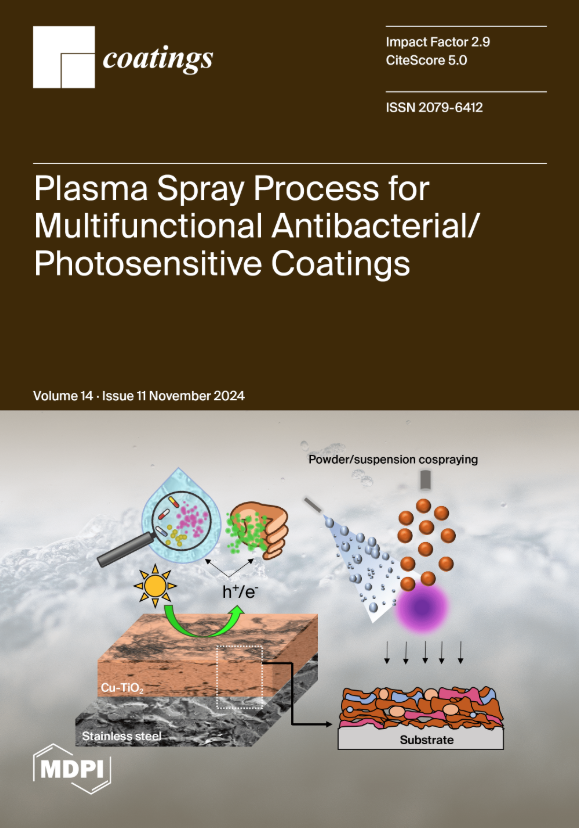Microstructure and Tribological Properties of WC/Ni-MoS2 Titanium-Based Composite Coating on TC4
IF 2.8
3区 材料科学
Q2 MATERIALS SCIENCE, COATINGS & FILMS
引用次数: 0
Abstract
To improve the mechanical properties of a TC4 surface, TC4 + Ni-MoS2 + xWC (x = 5%, 10% and 15% wt.%) composite coatings were prepared by the coaxial feeding laser cladding technique, and the effect of the WC content on the microstructure and tribological properties of the coatings were investigated using multiple characterization methods. The results indicated that increasing the WC content negatively impacted the forming quality of the coating, but did not change the coating phase which predominantly comprised Ti2Ni, Ti2S, TiC, matrix β-Ti and residual WC. With the addition of WC, TiC exhibited an increase in both quantity and particle size, accompanied by a transition in growth morphology from spherical to petal-like. MoS2 completely dissolved in all coatings and the S element provided by it effectively synthesized a strip-like phase Ti2S which presented a morphology similar to the lubricating phase TiS in the Ti-based melt pool system. The microhardness and wear-resistance of all the coatings were higher than that of TC4 and gradually improved with the addition of WC, which indicated that raising the WC content was conducive to enhancing the mechanical properties of the coatings. The friction coefficient of TC4 was lower than that of the three WC content coatings, indicating that Ti2S was not the lubricating phase. The wear mechanism of all coatings was abrasive wear.TC4 上 WC/Ni-MoS2 钛基复合涂层的微观结构和摩擦学特性
为了改善 TC4 表面的机械性能,采用同轴进给激光熔覆技术制备了 TC4 + Ni-MoS2 + xWC(x = 5%、10% 和 15% wt.%)复合涂层,并使用多种表征方法研究了 WC 含量对涂层微观结构和摩擦学性能的影响。结果表明,增加 WC 含量会对涂层的成形质量产生负面影响,但不会改变涂层相,涂层相主要由 Ti2Ni、Ti2S、TiC、基体 β-Ti 和残余 WC 组成。随着 WC 的加入,TiC 的数量和粒度都有所增加,同时生长形态也从球形转变为花瓣状。MoS2 完全溶解在所有涂层中,其提供的 S 元素有效地合成了条状相 Ti2S,其形态与钛基熔池体系中的润滑相 TiS 相似。所有涂层的显微硬度和耐磨性均高于 TC4,并随着 WC 的添加而逐渐提高,这表明提高 WC 的含量有利于增强涂层的机械性能。TC4 的摩擦系数低于三种 WC 含量的涂层,表明 Ti2S 不是润滑相。所有涂层的磨损机制都是磨料磨损。
本文章由计算机程序翻译,如有差异,请以英文原文为准。
求助全文
约1分钟内获得全文
求助全文
来源期刊

Coatings
Materials Science-Surfaces, Coatings and Films
CiteScore
5.00
自引率
11.80%
发文量
1657
审稿时长
1.4 months
期刊介绍:
Coatings is an international, peer-reviewed open access journal of coatings and surface engineering. It publishes reviews, research articles, communications and technical notes. Our aim is to encourage scientists to publish their experimental and theoretical results in as much detail as possible. There is no restriction on the length of the papers. Full experimental and/or methodical details must be provided. There are, in addition, unique features of this journal:
* manuscripts regarding research proposals and research ideas will be particularly welcomed
* electronic files or software regarding the full details of the calculation and experimental procedure - if unable to be published in a normal way - can be deposited as supplementary material
 求助内容:
求助内容: 应助结果提醒方式:
应助结果提醒方式:


